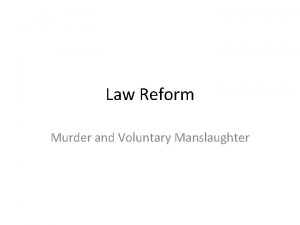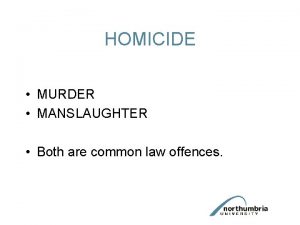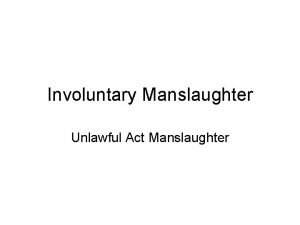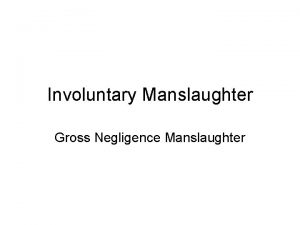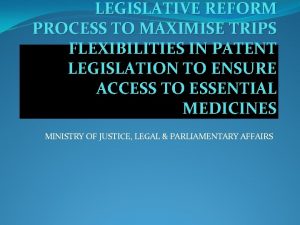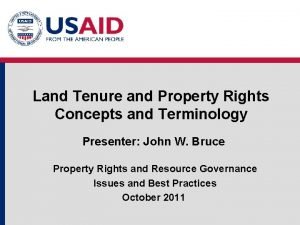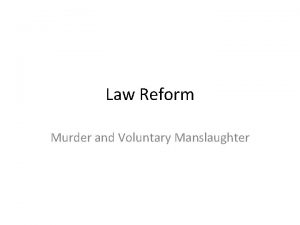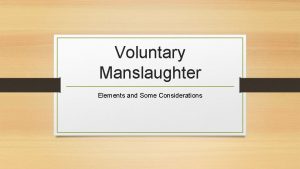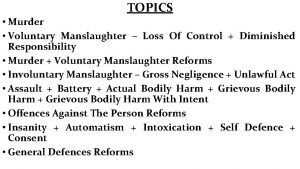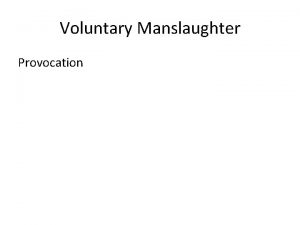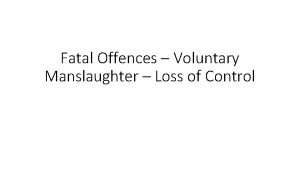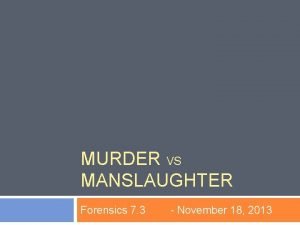Law Reform Murder and Voluntary Manslaughter Example Questions

















- Slides: 17

Law Reform Murder and Voluntary Manslaughter

Example Questions • In recent years, there has been much dissatisfaction with the current law of murder and voluntary manslaughter. Explain the reasons for this dissatisfaction and consider what proposals have been made for the reform of the law. (25 marks) • Despite some recent reforms, there are still criticisms to be made of the current law on murder and voluntary manslaughter. Consider relevant criticisms of that law, and suggest any reforms that may be appropriate. (25 marks)

Mark Scheme • Potential Content • (A) General structural criticisms of the law of murder. Criticisms of specific aspects of actus reus and mens rea. • (B) Criticisms of the defence of loss of control and/or of the amended defence of diminished responsibility. • (C) Appropriate suggestions for reform, in relation to either or both (A) and (B). • [NB – credit should be given for any explanatory material on which criticisms are founded. ]

Law Commission Consultation Paper 2006 ‘A New Homicide Act for England Wales? ’ (Consultation Paper Number 177) • In the paper, the current homicide law is described as ‘a rickety structure set upon shaky foundations’. • http: //lawcommission. justice. gov. uk/docs/cp 177 _Murder_Manslaughter_and_Infanticide_consult ation_overview_. pdf

Problem and reform (1) • murder has developed piecemeal through individual cases it DOES NOT WORK COHERENTLY WITH MANSLAUGHTER or as an offence. The term malice aforethought is archaic and creates a complex web of definitions through cases. Vickers was criticised in Hyam The HOL rejected this and in Cunningham (1981) felt that even though this was a problem, implied malice acts as a deterrent to those committing serious violence in society. • A LAW REFORM proposal is seen in the LC’s draft Criminal Code abolishes implied intention as the D can only have Malice aforethought if they intend to kill or are aware that the serious harm they have caused may also cause death. With the LC’s 2006 reforms of murder proposing 1 st , 2 nd degree murder and manslaughter this would clearly create a much more coherent structure of offences more fairly linked to D’s mental state and conduct.

Problem and reform (2) • The MENS REA of murder is unclear as to what should be foreseen by the D. The HOL decision in Woollin adopted Prof Glanville Williams view that the jury should look objectively at whether death was a virtual certainty of the D’s actions and if so then look subjectively at whether or not the D appreciated the consequence would happen as a VC. Not clear whether the Woollin test is a substantive rule of law or, as suggested by the CA in Matthews & Alleyne, a rule of evidence. • The LC proposed REFORM of the word ‘intentionally’ (Offences Against the Person and General Principles (1993)) as it would only allow MR for murder where it is clear from the evidence D intended to kill or that this would be the result in the ordinary course of the events started by the D. The LC (2006) has suggested indirect intention would be more fairly dealt with as 2 nd degree murder unless evidence shows D was aware of significant risk of death.

Problem and reform (3) • The Criminal Law Act 1967, s 3 states that a person may use ‘such force as is reasonable in the circumstances’ in self-defence or to prevent a crime being committed. What is reasonable depends on what the defendant honestly and instinctively thought the needs of the moment to be. This leads to an ‘all or nothing’ situation where there is either a complete defence or it is considered disproportionate and is found guilty of murder. – Clegg, Martin • In February 2005, the CPS and Association of Chief Police Officers jointly issued a leaflet containing new guidelines. If householders use what they believe was ‘necessary in the heat of the moment’, they are unlikely to end up in court. This is the case even if a weapon is used an intruder dies. Cannot use force maliciously but the more extreme the circumstances, the more force you can use in self-defence. • Law Commission suggested selfdefence might be made a partial defence, or that mandatory lifesentence be abolished

• http: //www. cps. gov. uk/ • http: //www. bbc. co. uk/ publications/prosecutio news/uk-politicsn/householders. html 13957587 • http: //news. bbc. co. uk/ 1/hi/uk/6902409. stm

Problem and reform (4) • The MANDATORY LIFE SENTENCE doesn’t allow judges any discretion to reflect the extreme of culpability of D’s who commit the offence. Murder can range Sutcliffe, to those who kill from motives of compassion, (‘mercy killers’) such as the Pretty case, or those like Martin who overstep the limits of reasonable force in self-defence. Juries compound this problem either by issuing a complete acquittal, say in cases of assisted suicide or to allow defences such as diminished responsibility on the flimsiest of evidence. • The LC proposals for a 2 tier murder structure recommended that a mandatory sentence should only apply to first degree murder.

• • • Rosemary West Diane Pretty Tony Martin Kiranjit Ahluwalia Peter Sutcliffe

Problem and reform (5) • Murder criticised for • The LC recommended what INEFFECTIVELY MANAGING now is the new defence of THE DIFFERENT TYPES OF Loss of control (LOC) in the KILLING that it currently covers. Coroner and Justice Act. LOC For example in self defence NAROWS THE USE OF this cases like Martin or Clegg partial defence so that the where the D fails to show they judge has more control over used reasonable force the D is when it can be used, such as treated as a murderer in the where the D incited the same way as Rosemary West, provocation in Smith: Morgan. and in Battered wives killings such as Ahluwalia who kill not for revenge but to escape years of torture and violent treatment.

Loss of Control • The new FEAR TRIGGER has been made COMPLEX by the government’s insistence on including the LOC aspect of the defence. The explanatory notes say fear cannot be of a future beating, as in Ahluwalia, as this would not satisfy the LOC aspect of the defence. For self defence would Martin’s instinctive reaction to shoot fail anyway as he would have to prove a LOC? • The ANGER TRIGGER has been reformed by the inclusion of the requirement for the things said/done to be grave and specifically make a reasonable person feel wronged. This means cases like Doughty (baby crying was provocation) would no longer be viewed by the jury as passing either of these tests. However the new defence does not define the phrases so in cases like Clarke on an objective direction to the jury clearly this will produce a different result and is clearly dissatisfactory.

Diminished Responsibility • With Diminished Responsibility (DR) the 2009 reforms of the Homicide Act go some way to making the old defence more satisfactory about the criticism over CONFLICTING MEDICAL EVIDENCE being raised. The defence has a clear link to recognised medical conditions from set lists, e. g. WHO. However in cases like Ahluwalia where the condition of BWS was not actually recognised at the time of the trial could still be problem. Not sure if any real distinction between an ABNORMALITY OF MENTAL FUNCTIONING and a recognised medical condition. Complicating the defence with this undefined phrase clearly encourages inconsistency in cases and it is not clear whether the classic definition in Byrne is still appropriate. • DR still requires the D to prove the defence, which has been challenged previously on a person’s HUMAN RIGHT to be innocent until proven guilty. However the government’s argument was that the standard of proof was lower, on balance of probabilities, and that it more satisfactory for the D who has medical evidence from his doctor to prove this diminished his criminal responsibility.

Diminished Responsibility • The reform of DR DOES NOT RESOLVE THE PROBLEM OF INTOXICATION as a recognised medical condition, such as alcohol dependency syndrome (Wood), or the dual effects issues of intoxication and a medical condition (Gittens). The new defence is unclear as to whether it is now justified to allow alcoholics a defence without having to look at voluntary and involuntary drinking?

Reclassification of Homicide


Reclassification of Homicide • In the LC 2006 report on Homicide murder would be reclassified into first and second degree. First degree would cover intentional killing or where the D can be shown to be aware of a serious risk of death, for which there would be a mandatory life sentence. This would resolve many of the MR problems discussed such as abolishing implied intention through D’s intention to cause GBH. Second degree murder would now include both implied malice and the partial defences of LOC and DR with a discretionary life sentence and a more satisfactory link to the D’s culpability. The government formally rejected all proposals, except for reform on Voluntary manslaughter, in 2008, so clearly it will be left to judicial precedent, with all its complexities to try an ensure the dissatisfactions raised are as far as possible left in a satisfactory state.
 Diminished responsibility in criminal law
Diminished responsibility in criminal law Voluntary manslaughter
Voluntary manslaughter What is indirect voluntariness
What is indirect voluntariness Manslaughter common law
Manslaughter common law What will johnny be charged with for killing bob
What will johnny be charged with for killing bob Example of involuntary manslaughter
Example of involuntary manslaughter Newton's first law and second law and third law
Newton's first law and second law and third law Si unit of newton's first law
Si unit of newton's first law Unlawful act manslaughter definition
Unlawful act manslaughter definition Gross negligence manslaughter actus reus
Gross negligence manslaughter actus reus Involuntary manslaughter
Involuntary manslaughter Law reform process
Law reform process Bayan-anihan president
Bayan-anihan president Ano ang land tenure reform law tagalog
Ano ang land tenure reform law tagalog Land reform def
Land reform def Mga pangulo ng ikatlong republika ng pilipinas
Mga pangulo ng ikatlong republika ng pilipinas V=k/p
V=k/p Constant in avogadro's law
Constant in avogadro's law
